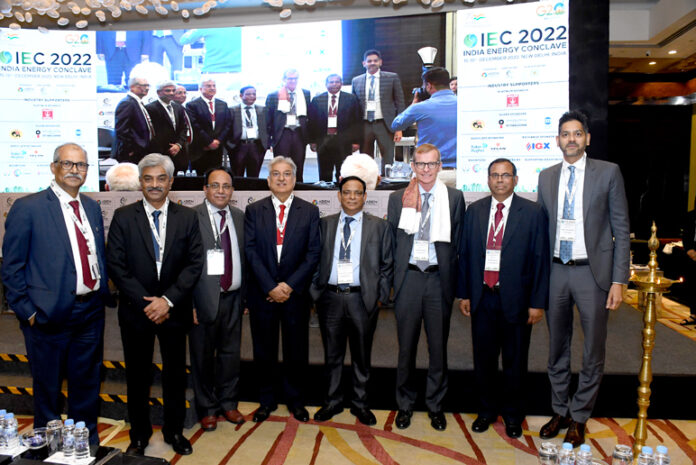India Energy Conclave (IEC 2022) in New Delhi on deliberates on ‘Global Energy Transition Trends: Sustainable Energy Options for India- Target Carbon Neutral 20270’
New Delhi: In view of the current geopolitical situation and COP 27 targets to achieve Net-Zero carbon by 2070, experts emphasized on robust energy mix with alternative sources for energy security, affordability, and sustainability. Speaking at India Energy Conclave (IEC) 2022, experts and top energy professionals said that the governments and countries including India have realized that in the current geopolitical situation energy security can be achieved through renewables. According to them, a balance between conventional, renewables, natural gas, biogas, and hydrogen has to be maintained for energy security, affordability, and sustainability. Experts were of the view that India needs to invest over $400 billion in the Green Energy sector to deal with the energy trilemma -Security, Affordability and Sustainability
India Energy Conclave (IEC 2022), organized in New Delhi, deliberated on ‘Global Energy Transition Trends: Sustainable Energy Options for India- Target Carbon Neutral 20270’ and an exhibition on ‘Sustainable Solutions’ highlighted the potential and opportunities in renewables.
In his special address, BC Tripathi, former CMD, GAIL India Ltd., highlighted the challenges of climate change and net-zero targets in the context of the energy transition. “The transition needs to be very well calibrated while opting for other sources of energy. We need energy for sustainable and robust growth. By 2040, energy demand would be doubled from its current levels. The challenge is to maintain the energy basket. The inflexion point is what the mix should be in the basket,” said Tripathi.
“We need to speed up investment, infrastructure, and manufacturing capacity for renewables if we want to achieve 500 GW (gigawatts) in the next 2030 and it would require nearly $200 billion investment. Similarly, for the target of green hydrogen, India needs to invest $150 billion. So, altogether, a huge investment of $350-$400 billion would be required to achieve 40 % of green power by 2030. To overcome the challenge of the unpredictability of renewables, a huge capacity for energy storage would be required. The government is expected to come out with Energy Storage Policy soon. Several policy measures are required to create a robust ecosystem for integrating renewables into our energy systems,” emphasized BC Tripathi.
The Conclave also witnessed the Presence of Dr. Kirit Parikh, Chairman, IRADe, Former member, Planning Commission Govt. of India. He talked about the Important Steps that needs to be taken for Energy Security of India & also the Energy Transition.
According to experts, there is an elephant in the room (emissions) when nations talk about the energy transition. The countries need to address the climate change resulting from emissions and ensure limiting global warming to 1.5 degrees to 1.6 degrees. For this, the world needs to reduce emissions by 37%.
Amrit Vaidhynath, Senior Vice President Rystad Energy said, “Net Zero pledge is a positive step. But, current geopolitics has now shifted the focus away from sustainability to energy security. We’ve actually seen an increase in coal use and no significant reduction in methane emissions and continuing deforestation. So this is certainly concerning, and this needs to be addressed. However, countries and governments are now realizing that they can achieve energy security through renewables. What this essentially means is that a balance needs to be achieved between secure energy security, affordability, and energy sustainability.”
Prominent energy professionals and experts also underpinned the importance of enhancing manufacturing capacity in terms of equipment components. Upgrading electricity grids, expanding storage capacity, and increasing manufacturing capacities are the keys to a seamless energy transition.
India aspires to become a green hydrogen hub. The Conclave highlighted that the use of hydrogen will lead to decarbonisation effects in these industries in terms of the role that India plays on the global stage.
“India is the third largest emitter and any climate action that India takes will mean that it will be a tremendous boost to global climate effort. So India has a tremendous opportunity to lead by example,” said Vaidhynath adding that India can also significantly cut the cost of power generation by using renewables into the fossil fuels and this brings in the affordability element in addition to security as well.
India has a very ambitious target of 500 gigawatts of capacity in 2030 in terms of non-fossil fuel power generation capacity and India certainly heading in that direction. And a bright spot was that in 2021, the renewables capacity constructed was substantially more than the coal-fired capacity. According to experts, India is looking to become a low-cost green energy hub, and this very much aligns with renewables.
The IEC 2022 also witnessed the unveiling of a book- ‘The World of Liquified Natural Gas’ by written by Mr. Rajeev Mathur, Mormer MD, Mahanagar Gas Ltd. & Mr. Ravishankar Sundaresan, CEO Yes We can Adademy, which gives an in-depth analysis of the LNG business.
The Energy Trilemma, which refers to finding a balance between security, affordability, and sustainability, is critical for India. Earlier, in his address, Monte Dobson, CEO and Lead Country Manager, Exxon Mobil India said, “Shale has really changed the energy landscape globally, providing tremendous benefits to the US and actually the world. India’s energy ecosystem would have a similar impact because energy India’s path through the energy trilemma is actually critical to the world.”
“Exxon Mobil pioneered LNG coming into India. LNG is going to be an important part of the distribution. Today, India stands on the cusp of economic ascendance. Energy is a critical engine of economic growth as India grows its energy needs will grow as well. The IEA estimates that between 2021 and 2030, a doubling of the country’s energy demand. Now, we have cutting-edge technologies that can increase production capacity by 20%. India can exploit this resource and improve its position in energy security and also improve energy affordability,” added Monte Dobson.
Experts also emphasized that the development of resources is not only essential to energy security but it also unlocks benefits across the economy including offering additional opportunities for integrated operations. They recommend that the government needs to provide a robust policy push with a rational regulatory framework and investor protection measures. With these policy reforms international companies will find India an appropriate place to invest are such as Exxon Mobil or other international companies will find any appropriate place to invest billions of dollars that are ultimately required to develop deep natural resources.
To get more updates, Follow us on Facebook, Twitter and Instagram. You can also join our Telegram Channel























